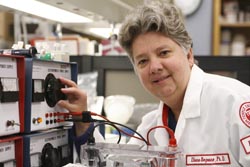School of Medicine scientists pinpoint protein function
|
For the first time, researchers are reporting on the function of the acinus-S' protein as it relates to gene expression. Acinus-S' binds to and represses the activity of retinoic acid receptors. Lead researcher Dianne Soprano, professor of biochemistry at the Temple University School of Medicine, hopes that the protein could one day be used to modulate the expression of genes regulated by retinoic acid, the active form of vitamin A. Soprano and her fellow researchers published their findings in the April issue of Molecular and Cellular Biology. Soprano focuses her research on retinoic acid receptors, which mediate the actions of vitamin A. Vitamin A is necessary for many critical biological functions in adults, children and embryos, but too much of it leads to abnormal gene expression and unwanted side effects. For example, exposure to high levels of retinoic acid during pregnancy results in congenital defects. |
|
“Other synthetic retinoic acid-like molecules are already used for treating skin diseases such as acne and psoriasis and are in clinical trials for certain types of cancer. But we don’t really know exactly how they act, and there are dangerous side effects,” Soprano said. “As we better understand this protein and its function, we could potentially modulate acinus-S’ levels in both people who are taking retinoic acid-like drugs or have an imbalance in naturally occurring retinoic acid.” Ultimately, modulating the activity of this protein could be helpful in creating lower doses of retinoic acid that are still effective, but with fewer side effects. |
 Photo by Ryan S. Brandenberg/Temple University
Dianne Soprano, professor of biochemistry, focuses her research on retinoic acid receptors, which mediate the actions of vitamin A.
|
|
The research team now plans to further elucidate the mechanism by which the protein regulates gene expression. Other members of the research team include Zivjena Vucetic, Zhenping Zhang, Jianhua Zhao, Fang Wang and Kenneth J. Soprano of the Department of Biochemistry, the Department of Microbiology and Immunology, and the Fels Institute for Cancer Research and Molecular Biology at the School of Medicine. This work was supported by National Institutes of Health grants and a grant from the Pennsylvania Department of Health.
|
|